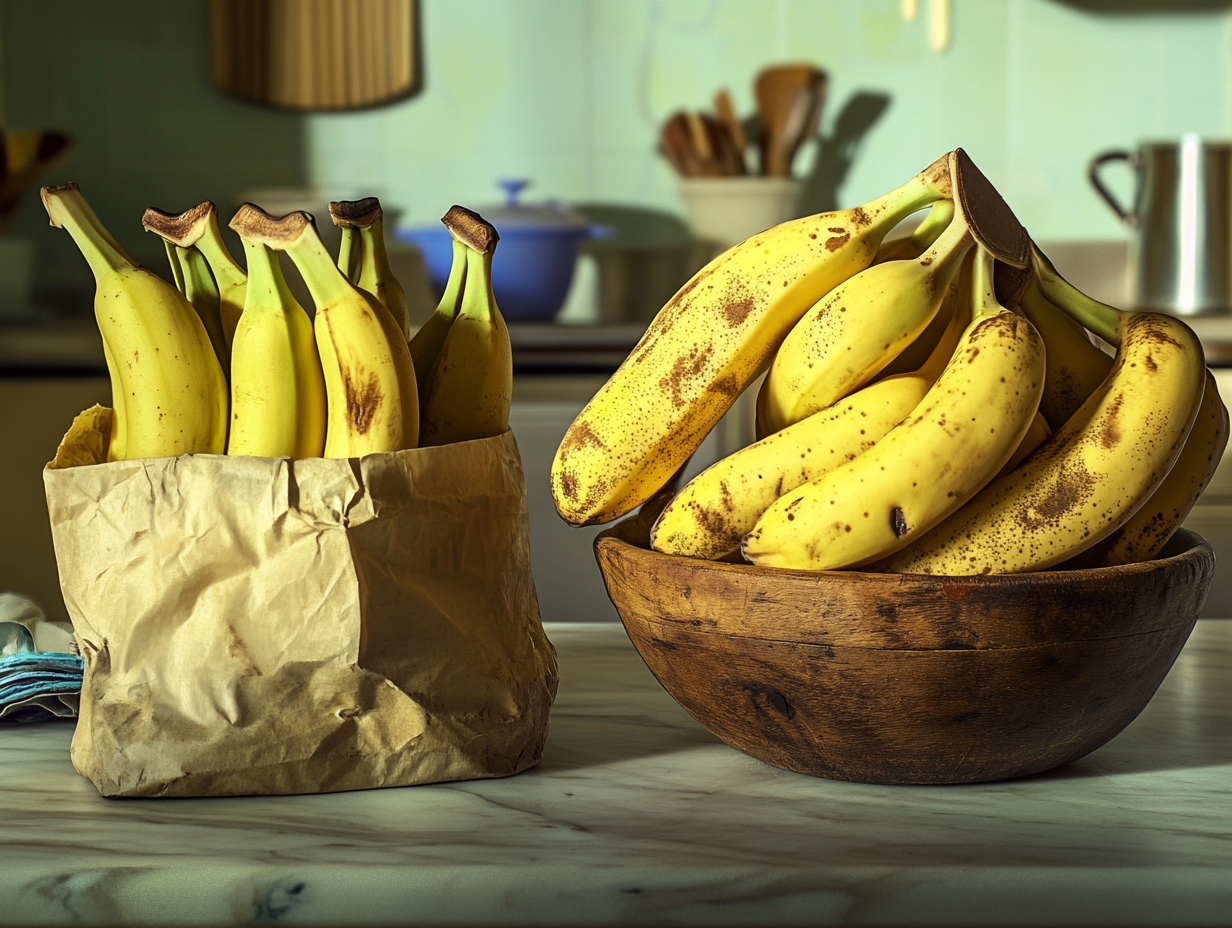How Ripe Do My Bananas Need to Be for Banana Bread?
Banana bread, a classic favorite in many households, owes its charm to the bananas you choose. But how ripe do my bananas need to be for banana bread to turn out perfectly? While it might seem like any banana will do, the truth is that ripeness plays a pivotal role in flavor, texture, and even the overall success of your bake. This article dives deep into every aspect of banana ripeness, from recognizing the ideal stage to speeding up the process when time isn’t on your side. Plus, you’ll learn essential tips to avoid common pitfalls and elevate your banana bread game.
Part 1: Understanding Banana Ripeness
The Importance of Banana Ripeness in Baking
When it comes to banana bread, the ripeness of bananas can make or break the recipe. The natural sugars in bananas develop as they ripen, transforming the fruit’s starchy interior into a sweet, aromatic delight. Overripe bananas not only add moisture but also enhance the bread’s richness, giving it a melt-in-your-mouth texture. Conversely, under-ripe bananas may leave your bread bland or dense.
Incorporating ripe bananas for banana bread ensures that your bake is both flavorful and tender. By using bananas with dark brown or black spots, you harness their full potential—sweetness, softness, and aromatic complexity.
Stages of Banana Ripeness
Bananas go through several ripeness stages, and each brings its own characteristics to the table. Recognizing these stages will help you make the best decision for your banana bread recipe.
Green Bananas
At the green stage, bananas are firm and slightly bitter, with high starch content and low sugar. These bananas are unsuitable for baking as they lack the necessary sweetness and softness.
Yellow Bananas
Yellow bananas, especially those without spots, are moderately sweet and ideal for snacking. However, they still aren’t soft enough to contribute to the creamy texture needed in banana bread.
Brown and Black Bananas
When bananas turn brown or even black, their starch has converted almost entirely into sugar, making them perfect for baking. At this stage, they are soft, fragrant, and sweet—exactly what banana bread calls for.
Pro Tip: If you’re unsure whether your bananas are ripe enough, give them a gentle squeeze. The softer they feel, the better suited they are for baking.
Ideal Ripeness for Banana Bread
Flavor Profile
Bananas that are slightly overripe, with at least 80% of their peel covered in dark spots, are ideal. They offer an intense natural sweetness that eliminates the need for excessive sugar in the recipe.
Texture Considerations
Soft bananas blend seamlessly into the batter, ensuring a smooth consistency. If your bananas feel mushy to the touch or are nearly blackened, they’re perfect for baking.
Next up: Part 2 – Achieving the Perfect Banana Ripeness.
Part 2: Achieving the Perfect Banana Ripeness
How to Ripen Bananas Quickly
Sometimes, you’re in the mood for banana bread but your bananas aren’t ripe enough. Don’t fret! There are several tried-and-true methods to speed up the ripening process without compromising flavor or texture.
Paper Bag Method
One of the simplest ways to ripen bananas is by placing them in a brown paper bag. Bananas naturally emit ethylene gas, a compound that accelerates ripening. When enclosed in a bag, the gas concentrates around the bananas, ripening them faster.
- Steps to Follow:
- Place your unripe bananas in a brown paper bag.
- Add an apple or another ripe banana to boost ethylene production.
- Seal the bag loosely and check the bananas daily.
Within 1–3 days, you’ll have bananas perfect for baking!
Oven Ripening Technique
If you’re pressed for time, ripening bananas in the oven is a game-changer. This method softens the bananas and brings out their sweetness in a matter of minutes.
- Steps to Follow:
- Preheat your oven to 300°F (150°C).
- Place the unpeeled bananas on a baking sheet lined with parchment paper.
- Bake for 15–20 minutes, or until the skins turn black and shiny.
- Let them cool before peeling and mashing.
Microwave Method
Need ripe bananas right now? The microwave method can ripen your bananas almost instantly.
- Steps to Follow:
- Poke the banana peel several times with a fork to prevent it from bursting.
- Microwave on high for 30 seconds to 1 minute, checking frequently.
- Cool the banana before using it in your recipe.
Caution: This method works best for slightly underripe bananas, not green ones.
Storing Ripe Bananas for Future Use
When you’ve got ripe bananas but no immediate plans to bake, proper storage is key. This ensures they’re ready whenever inspiration strikes.
Refrigeration
Ripe bananas can be stored in the refrigerator for up to a week. While the peel may darken, the fruit inside remains perfectly usable. Simply peel and mash them when you’re ready to bake.
Freezing Techniques
Freezing bananas is an excellent way to preserve their ripeness for months.
- Steps to Freeze Bananas:
- Peel the bananas to avoid difficulty when defrosting.
- Slice them into chunks for easy measuring and blending.
- Store in airtight bags or containers, removing as much air as possible.
When it’s time to use them, let the bananas thaw at room temperature or microwave them for a few seconds.
Next up: Part 3 – Baking the Perfect Banana Bread.
Part 3: Baking the Perfect Banana Bread
Classic Banana Bread Recipe
Banana bread is more than just a tasty treat—it’s a heartwarming reminder of home. While countless variations exist, a classic banana bread recipe remains timeless. Using ripe bananas for banana bread is essential to achieving that perfect flavor and texture.
Ingredients
Here’s what you’ll need for a classic loaf:
- 3–4 overripe bananas (mashed)
- 1/2 cup (115g) unsalted butter (melted)
- 3/4 cup (150g) sugar (adjust based on banana sweetness)
- 2 large eggs
- 1 teaspoon vanilla extract
- 1 teaspoon baking soda
- 1/2 teaspoon salt
- 1 1/2 cups (190g) all-purpose flour
Step-by-Step Instructions
- Preheat and Prep: Preheat your oven to 350°F (175°C). Grease and line a 9×5-inch loaf pan with parchment paper.
- Mash the Bananas: Use a fork or potato masher to mash your ripe bananas until smooth.
- Combine Wet Ingredients: In a large mixing bowl, whisk together melted butter, sugar, eggs, and vanilla extract. Stir in the mashed bananas.
- Incorporate Dry Ingredients: Gradually fold in flour, baking soda, and salt until just combined. Avoid overmixing, as it can make the bread dense.
- Pour and Bake: Pour the batter into the prepared loaf pan and bake for 50–60 minutes, or until a toothpick inserted into the center comes out clean.
- Cool and Serve: Let the bread cool in the pan for 10 minutes, then transfer it to a wire rack to cool completely before slicing.
Tip: For an added crunch, sprinkle chopped nuts or chocolate chips on top before baking.
Common Mistakes to Avoid
Using Under-Ripe Bananas
If your bananas are not ripe enough, the bread may lack flavor and sweetness. Remember, the darker and spottier the bananas, the better!
Overmixing the Batter
Overmixing activates gluten, which can make your bread tough and chewy. Stir the batter just enough to combine the ingredients.
Enhancing Your Banana Bread
Adding Nuts and Chocolate Chips
Chopped walnuts, pecans, or chocolate chips can elevate your banana bread from simple to spectacular. Fold these into the batter for bursts of flavor and texture.
Incorporating Spices
Warm spices like cinnamon, nutmeg, or even a dash of cardamom can add depth to your banana bread. A teaspoon of cinnamon is usually enough to complement the bananas without overpowering them.
Next up: Part 4 – Frequently Asked Questions (FAQs).
Part 4: Frequently Asked Questions (FAQs)
Can I use frozen bananas for banana bread?
Absolutely! Frozen bananas are an excellent option for banana bread. Freezing preserves their ripeness, ensuring they’re sweet and soft when thawed. To use frozen bananas:
- Allow them to thaw at room temperature or in the microwave.
- Drain any excess liquid after thawing to prevent the batter from becoming too runny.
Frozen bananas often result in a rich, moist banana bread, making them an ideal choice.
What if my bananas aren’t ripe enough?
If your bananas are under-ripe, you can use quick ripening techniques to bring them up to speed. For instance:
- Use the paper bag method or oven ripening technique to accelerate the process.
- Avoid green bananas, as they lack the sweetness and texture needed for a flavorful loaf.
Bananas that aren’t ripe enough may lead to dense, less flavorful banana bread, so it’s worth taking the time to ripen them properly.
How can I store banana bread to keep it fresh?
To maintain the freshness and moisture of your banana bread:
- At Room Temperature: Wrap it in plastic wrap or foil and store it in an airtight container for up to 3 days.
- In the Refrigerator: Store it the same way for up to a week.
- In the Freezer: Wrap slices individually in plastic wrap, place them in a freezer bag, and store them for up to 3 months.
Thaw frozen slices at room temperature or microwave them for a quick snack.
Can I reduce the sugar in banana bread recipes?
Yes, you can! Overripe bananas are naturally sweet, so you can reduce added sugar by up to 25% without compromising the taste. Consider these alternatives for healthier sweetness:
- Use honey or maple syrup instead of refined sugar.
- Add a handful of raisins or chopped dates for natural sweetness.
Reducing sugar also brings out the bananas’ natural flavors, creating a balanced and delicious loaf.
Can I add other fruits to banana bread?
Definitely! Adding fruits like blueberries, raspberries, or diced apples can enhance the flavor profile of your banana bread. Fold the fruits gently into the batter to prevent overmixing and avoid crushing them.
Tip: If adding juicy fruits, reduce the mashed banana slightly to maintain the proper moisture balance.
Why is my banana bread not rising?
If your banana bread doesn’t rise properly, a few factors could be at play:
- Expired Baking Soda: Ensure your leavening agent is fresh and active.
- Overmixing: Too much stirring can deflate the batter.
- Incorrect Oven Temperature: Use an oven thermometer to confirm the actual temperature matches the setting.
By following these tips, you’ll achieve a perfectly risen loaf every time!
Next up: Conclusion – Wrapping Up Your Banana Bread Journey.
Conclusion: Wrapping Up Your Banana Bread Journey
Banana bread isn’t just a simple recipe—it’s a celebration of flavor, texture, and the perfect use of overripe bananas. From understanding how ripe bananas need to be for banana bread to exploring creative enhancements, this guide equips you with everything needed to bake a loaf that’s nothing short of perfection.
Remember, ripe bananas with dark brown spots or blackened skins are your best bet for a sweet, moist, and aromatic result. Whether you’re using fresh bananas, speeding up ripening techniques, or making the most of frozen ones, the key lies in balancing flavor and texture. And don’t forget the countless ways to personalize your banana bread, whether with spices, nuts, or even fruits.
So, the next time you find a bunch of overripe bananas sitting on your counter, don’t toss them—transform them into a delicious homemade treat. With these tips and tricks, you’ll be a banana bread expert in no time, ready to share the joy of this beloved classic with friends and family.
Happy baking!

